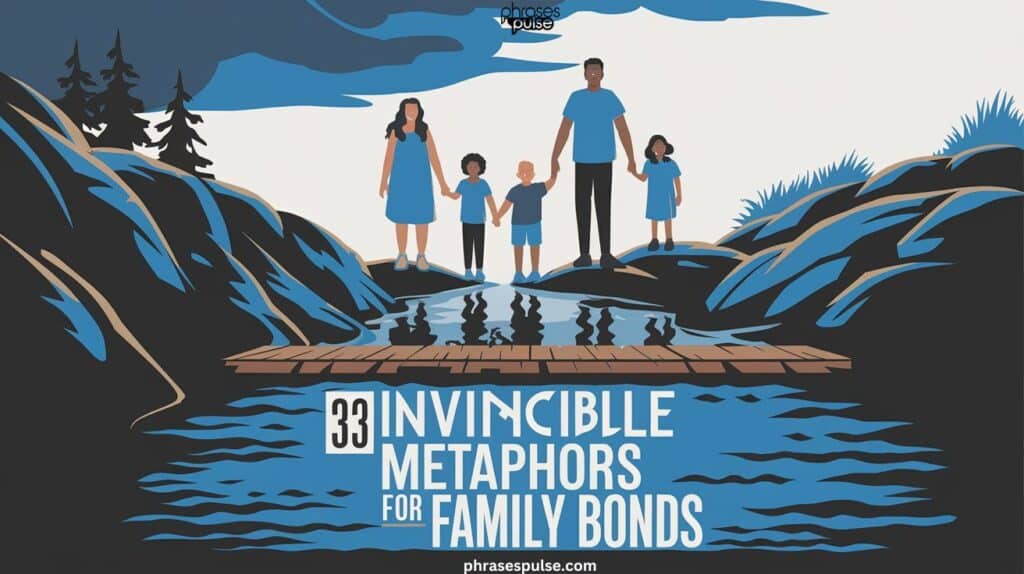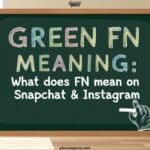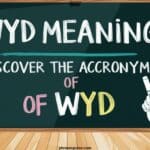Family isn’t just a group of people related by blood. It’s a powerful, shared experience that shapes our lives and identities. Using metaphors, we bring the concept of family closer to the heart, turning it into something more meaningful.
Through metaphors for family, we can express deep, emotional, and unique insights that are difficult to capture in literal terms. When we say, for instance, that “family is a rock” or “family is a lighthouse,” we’re giving our bonds depth, highlighting the guidance roles and stability that family provides.
These metaphors for family give us symbols and images that make our family connections feel even stronger. Whether it’s family warmth or family teamwork, metaphors help explain the complexity and importance of familial bonds.
Metaphors for Family
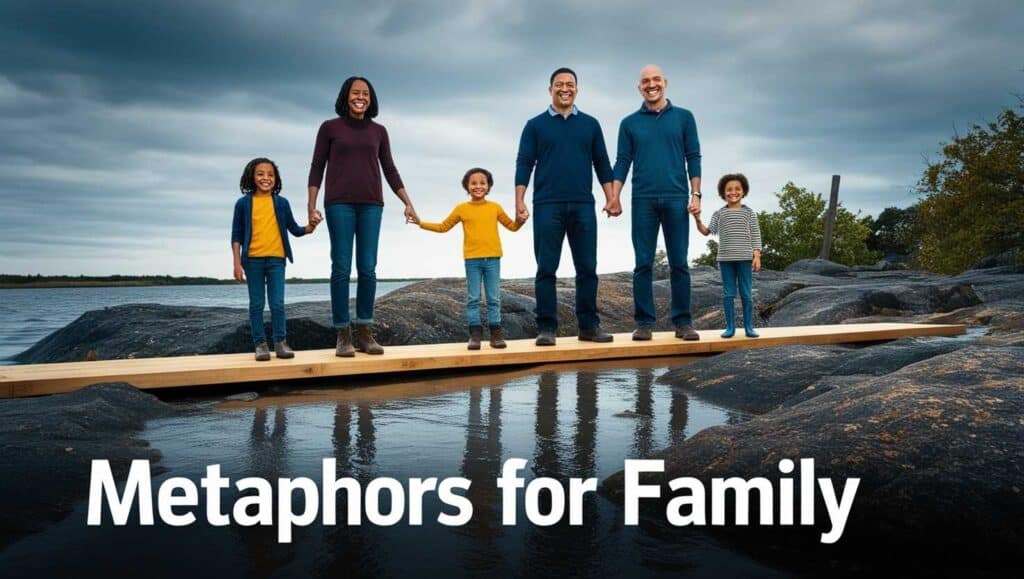
Family is a rock This metaphor represents the strength and stability of family. Like a rock, a family is there through life’s storms, providing a steady foundation. Family is a team – Families work together, supporting each other like teammates on a field. This metaphor highlights family teamwork and family cooperation.
Family is a lighthouse Acting as a guiding presence, family shines light during dark times, helping each member find their way. Family is a garden Just as a garden needs care to grow, families flourish through love and attention. Family is a puzzle Every family member is a unique piece, fitting together to create a complete picture.
Family as Support and Stability
| Metaphor | Description | Example |
|---|---|---|
| Family is a rock | Represents strength and stability. | “Through every challenge, my family is a rock.” |
| Family is a lighthouse | Guiding presence in dark times. | “Whenever I feel lost, my family is my lighthouse.” |
| Family is a shield | Provides protection and defense. | “In times of trouble, my family shields me.” |
| Family is a team | Family unity, working together. | “We face life as a team, always supporting each other.” |
| Family is a foundation | Basis of values and beliefs. | “My family is the foundation of who I am today.” |
| Family is an anchor | Keeps us grounded in turbulent times. | “No matter where I go, my family is my anchor.” |
| Family is a safety net | Catches us when we fall. | “My family is always my safety net.” |
| Family is a shelter | Family protection from life’s storms. | “When life gets hard, I find shelter in my family.” |
| Family is armor | Protects and strengthens against challenges. | “Family is the armor that shields us from life’s blows.” |
Family as Growth and Connection
| Metaphor | Description | Example |
|---|---|---|
| Family is a garden | Nurtures and allows family growth. | “With love and care, my family grows like a garden.” |
| Family is a tapestry | An interwoven blend of unique individuals. | “Our family is a tapestry of stories and memories.” |
| Family is a puzzle | Each member completes the whole. | “Every person in my family is a vital puzzle piece.” |
| Family is a recipe | A mix of unique family ingredients. | “Our family is a recipe of personalities and quirks.” |
| Family is a tree | Rooted, with branches that grow outward. | “We are all branches of the same family tree.” |
| Family is a symphony | Different parts working in family harmony. | “Each family member plays a part in our symphony.” |
| Family is a journey | An ongoing adventure with collective memories. | “My family is with me on life’s journey.” |
| Family is a classroom | A place of learning and growth. | “I learn life’s important lessons from my family.” |
| Family is a nest | Provides comfort and security. | “Our family nest is where we all feel safe and warm.” |
| Family is a beacon | Guidance roles in life’s stormy seas. | “No matter the darkness, my family guides me.” |
Family as Legacy and Heritage
| Metaphor | Description | Example |
|---|---|---|
| Family is a legacy | Carries family heritage forward. | “Our family legacy is one of kindness and strength.” |
| Family is a treasure | Precious and cherished. | “My family is the most valuable treasure I have.” |
| Family is a bridge | Connects past, present, and future generations. | “Our family acts as a bridge to our history.” |
| Family is a torch | Passes on wisdom and guidance. | “Our family carries a torch of resilience.” |
| Family is a home | Place of belonging and comfort. | “My family feels like home, wherever they are.” |
| Family is a quilt | Pieces stitched together, forming something whole. | “Our family quilt is made of love and memories.” |
| Family is a flame | Provides warmth, family energy, and guidance. | “The flame of family keeps us going in hard times.” |
| Family is a village | A community of support. | “It takes a village, and my family is that village.” |
| Family is a compass | Guides us in making choices. | “My family is my moral compass.” |
| Family is a chain | Unbreakable links connecting generations. | “We’re all links in the family chain.” |
| Family is a river | Flows with life’s ups and downs, shaping each other. | “Our family is like a river, carrying us forward.” |
| Family is a canvas | A shared masterpiece painted with memories. | “Our family’s life is painted on a canvas of moments.” |
| Family is a mirror | Reflects values and shared experiences. | “Looking at my family, I see a reflection of myself.” |
These family symbols give us a way to see family in a new light, making it clear how interconnected we all are in the grander family structure. By using figurative language like this, family becomes not just a group but a powerful, shared identity.
Metaphors for Family in Figurative Languages
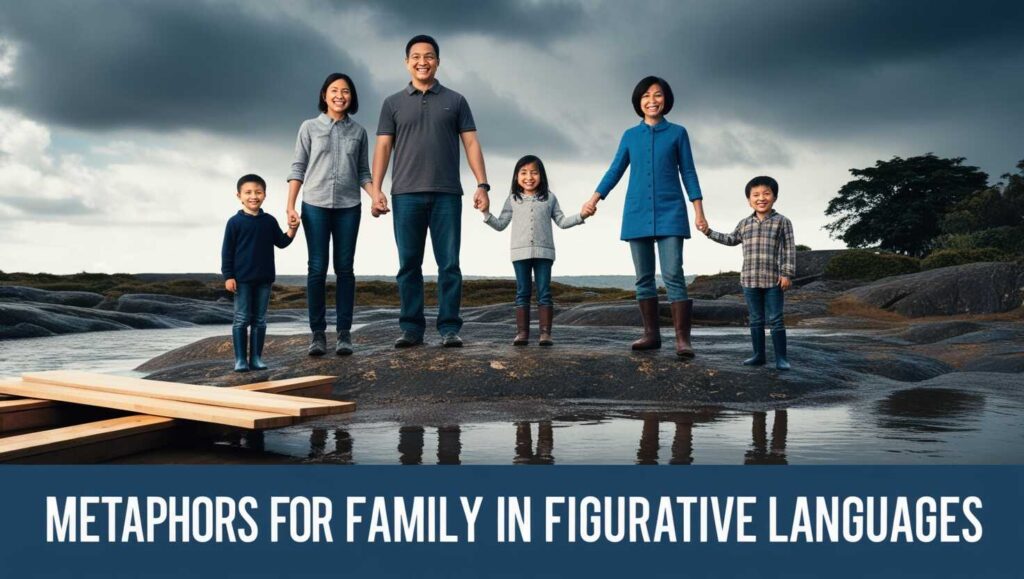
Across different cultures, people use rich metaphors to describe familial relationships. These metaphors go beyond literal language, showing us how families are seen universally as essential sources of love and support. In English, we might say that “family is a garden” or “family is a team.” Other cultures express family concepts through unique words and images, making each metaphor a reflection of cultural values and priorities.
For example, in Japanese, the term “Kazoku” carries both the idea of family as a unit and as a support system. In the Navajo language, family is often described as “K’é,” representing close-knit family ties where members rely on each other’s strength in adversity. These expressions remind us that families are interwoven ties that carry collective memories and provide resilience in tough times. Below, you’ll find a table showcasing some common family metaphors across cultures:
| Culture | Family Metaphor | Meaning |
|---|---|---|
| English | Family is a rock | Family is steady and reliable |
| Japanese | Family as “Kazoku” | Family as a unit of support |
| Navajo | Family as “K’é” | Close-knit ties with mutual reliance |
| Spanish | Family is a shield | Family provides protection |
Family Vacation Packages
Imagine family as a vacation package, a journey where every member has a role. In this metaphor for family, each family member brings something unique to the experience, contributing to the family mix that makes every family moment memorable. Just like a planned trip, a family journey has ups and downs, moments of laughter, and times when things go off track. But through it all, each person’s supporting role helps bring the journey to life.
This metaphor emphasizes the close connections and mutual reliance found in strong families. It highlights how a family vacation, like family life, is full of shared memories and collective past that binds members together. The journey isn’t always smooth, but it’s the support and love that make it worthwhile. This journey symbolizes family unity and shows how every member’s interconnected relationships create a foundation of trust and understanding.
What is Metaphors About Family?
A metaphor about family is a symbolic comparison that helps us express the essence of family relationships. By seeing family as something concrete, like a garden, tapestry, or shield, we gain a deeper understanding of what family means. Family imagery makes the abstract feel real, and family symbols reveal the many roles family plays in our lives.
Metaphors turn the simple word “family” into a meaningful concept filled with emotions, memories, and interwoven ties. Each metaphor carries a unique message, giving us a way to appreciate family from different perspectives. When we say “family is a warm hug” or “family is a recipe,” we capture the comfort, support, and diversity of family members.
8 Creative Metaphors for Understanding Internal Family Systems
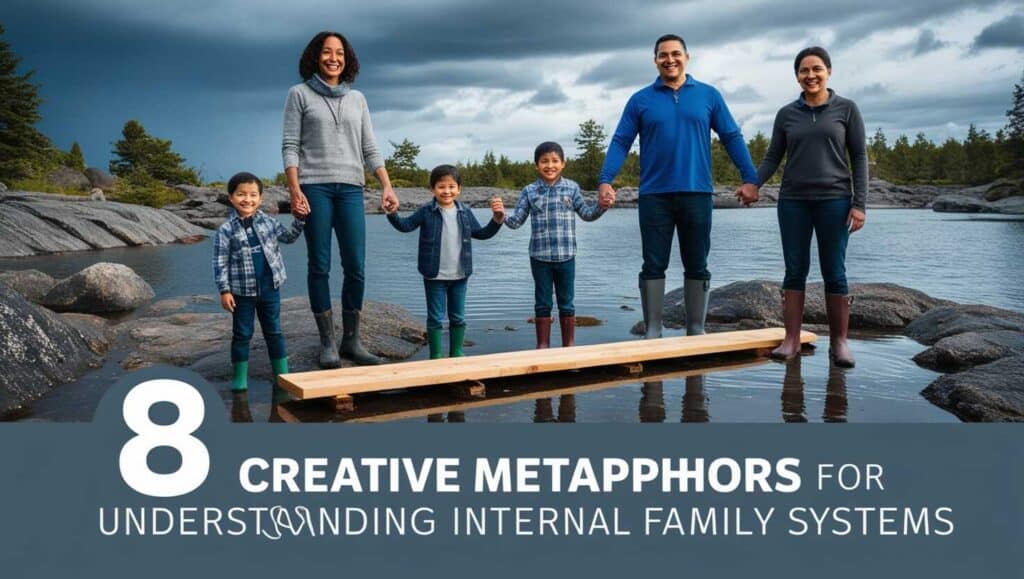
In exploring Internal Family Systems (IFS), metaphors offer powerful tools to help us understand this complex, deeply insightful therapeutic model. At its core, IFS views the mind as a system of interrelated parts, each part representing a unique aspect of our personality and emotions. Imagine each part as a piece of a puzzle, working in harmony to shape our thoughts, feelings, and behaviors. The central “Self” in IFS acts as a guiding force, fostering emotional harmony and helping us navigate the diverse elements within us.
Using metaphors brings these personality aspects to life, making the process of personal growth and development more relatable. These analogies serve as conceptual tools to illustrate how each “part” functions and interacts within the mind, helping us understand complex emotional landscapes in a meaningful way. Through eight unique metaphors, we can delve into themes of personal leadership, nurturing care, emotional management, and inner peace. Let’s explore each metaphor and how it helps paint a clearer picture of our internal world.
1. The Garden and the Gardener
This metaphor illustrates the “Self” as a gardener and each personality aspect as a different part of the garden. Just as the gardener tends to each plant with care, nurturing growth, so the Self cultivates balance within the mind, fostering personality growth and encouraging each part to thrive harmoniously.
2. The Story and the Blank Page
In this metaphor, each part of the personality is a different “chapter” in our ongoing life story. The Self is the author, creating a cohesive narrative while allowing each “chapter” or part to contribute its own voice. This analogy emphasizes storytelling and narrative creation in understanding our inner parts as characters in our life’s story.
3. The Room and Its Furniture
Imagine the mind as a room filled with furniture. Each piece of furniture represents a unique part of our personality, and the Self is the decorator who arranges everything to create balance. This metaphor helps visualize how inner peace is achieved by arranging our internal parts in a way that brings emotional balance and harmony.
4. Understanding Anger Through Moana
The animated character Moana’s journey mirrors the Self’s guidance in IFS. When Moana encounters challenges, she must navigate various aspects of her personality, from courage to fear. This metaphor illustrates emotional management, where anger, like Moana’s challenges, is acknowledged and worked through, fostering growth and resolution.
5. The CEO and the Employees
In this metaphor, the mind is seen as a company where the Self acts as the CEO and each part is an “employee” with specific roles and responsibilities. The CEO’s job is to lead and guide these parts, ensuring they work together for the well-being of the whole system. This highlights the importance of personal leadership and self-direction in achieving emotional balance.
6. The Orchestra and the Conductor
An orchestra’s harmony depends on each instrument playing in sync, directed by a conductor. The Self as conductor brings orchestra harmony, ensuring that each “instrument” or part of the personality plays its role, creating a synchronized and balanced inner experience.
7. The Ship’s Crew and Captain
This metaphor likens the mind to a ship with a captain (the Self) and crew members (personality parts). The captain must guide the ship with a steady hand, working alongside the crew. This analogy represents part integration and emphasizes inner unity in navigating life’s journey.
8. The Company Boardroom
Picture each part of the personality as a member seated at a boardroom table. The Self presides as the chair, hearing each part’s input to make wise decisions. This conceptual tool highlights how each aspect of the personality has a voice that, when acknowledged, leads to emotional harmony and self-improvement.
Through these creative metaphors, we gain a deeper understanding of Internal Family Systems and how each part of our personality contributes to our overall well-being and personal evolution. By exploring these analogies, we can better appreciate the complex inner workings that bring us closer to emotional harmony and personal balance.
History for Metaphor About Family
Throughout history, people have used metaphors to describe familial relationships. These symbolic ideas appear in literature, poetry, and folklore from various cultures. In ancient times, family was often compared to a tree or vine, showing how members are interwoven and share a common past. In Shakespeare’s plays, for instance, he frequently used family metaphors to discuss loyalty, love, and betrayal.
In modern times, metaphors have expanded, with new family expressions appearing to capture the evolving roles of families. Today, we may see family as a “support network” or as “armor” against life’s challenges, symbolizing the protection and defense family offers. These historical and modern perspectives show that family metaphors evolve, but they always emphasize family support, family heritage, and family stability as core values.
Frequently Asked Questions
What is an example of a family metaphor poem?
A family metaphor poem might describe family as a “tapestry,” with each member as a unique thread, woven together to create a beautiful and strong fabric. For example:
“Our family, a tapestry bright,
Threads interwoven, strong and tight.
Each stitch a story, joys, and tears,
Woven together through the years.”
This metaphor highlights how each family member contributes uniquely to the whole, creating something enduring and meaningful.
What is a good simile for family?
A good simile for family is, “Family is like a garden; it needs care, attention, and love to grow.” This simile conveys the idea that families flourish when nurtured and grow closer through shared efforts and care.
What are 10 examples of a metaphor?
- Family is a rock.
- Family is a lighthouse.
- Family is a warm hug.
- Family is a puzzle.
- Family is a tree with deep roots.
- Family is a symphony.
- Family is a garden.
- Family is a shield.
- Family is a recipe.
- Family is a tapestry.
Each of these metaphors represents unique aspects of family, from stability and guidance to warmth, unity, and protection.
What is the metaphor of the family tree?
The “family tree” metaphor represents family as a tree with deep roots (symbolizing ancestors) and branches (symbolizing different family members and generations). It illustrates how a family grows, expands, and shares a common origin, with each member connected yet branching out in their unique directions. This metaphor helps visualize the shared heritage and deep-rooted connections within a family.
Conclusion
In conclusion, family metaphors give us a powerful way to understand and appreciate the depth of familial bonds. Whether we see family as a rock, a shield, or a tapestry, each metaphor adds layers of meaning to the family experience. These expressions bring the comfort, security, and family warmth we often feel with loved ones to life.
Using metaphors for family helps us connect on a deeper level, reminding us of the family unity that binds us. Through shared memories and collective journeys, family becomes more than just a word; it’s a complex, resilient, and invincible force in our lives. Whether your family feels like a warm hug, a symphony, or a lighthouse guiding you home, these metaphors show how our interconnected relationships and family roles truly make family irreplaceable.

Ava Rose, the creator of PhrasesPulse, is an expert in English grammar with years of experience. She is dedicated to simplifying complex grammar rules and exploring the richness of English phrases. Through her insightful posts, Ava aims to help learners of all levels enhance their understanding of the language and communicate more effectively. Her passion is making grammar approachable and enjoyable for everyone.

